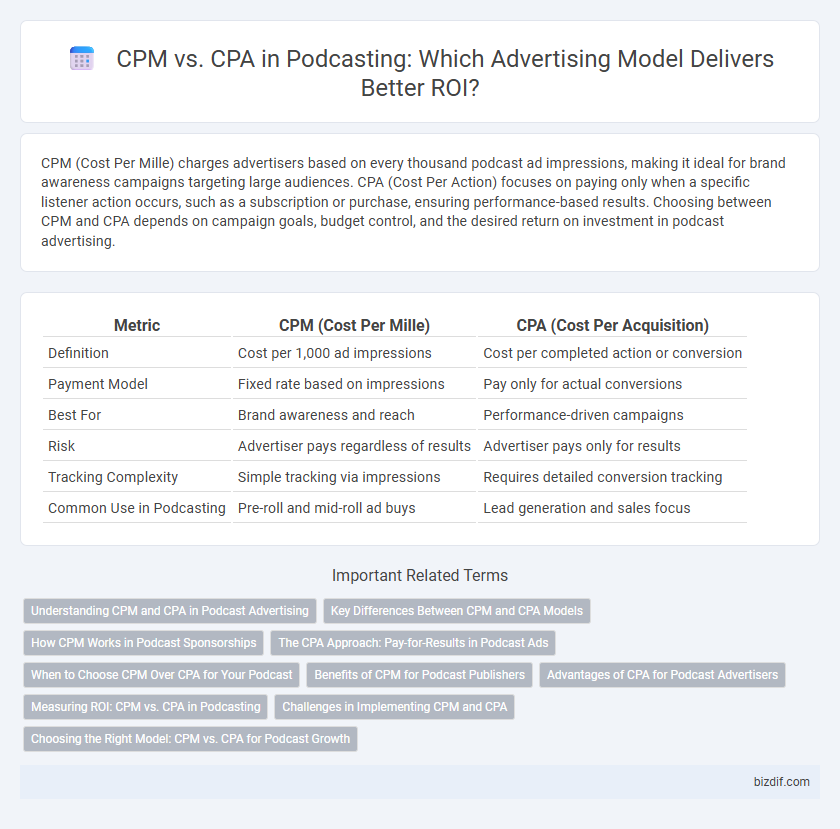CPM (Cost Per Mille) charges advertisers based on every thousand podcast ad impressions, making it ideal for brand awareness campaigns targeting large audiences. CPA (Cost Per Action) focuses on paying only when a specific listener action occurs, such as a subscription or purchase, ensuring performance-based results. Choosing between CPM and CPA depends on campaign goals, budget control, and the desired return on investment in podcast advertising.
Table of Comparison
| Metric | CPM (Cost Per Mille) | CPA (Cost Per Acquisition) |
|---|---|---|
| Definition | Cost per 1,000 ad impressions | Cost per completed action or conversion |
| Payment Model | Fixed rate based on impressions | Pay only for actual conversions |
| Best For | Brand awareness and reach | Performance-driven campaigns |
| Risk | Advertiser pays regardless of results | Advertiser pays only for results |
| Tracking Complexity | Simple tracking via impressions | Requires detailed conversion tracking |
| Common Use in Podcasting | Pre-roll and mid-roll ad buys | Lead generation and sales focus |
Understanding CPM and CPA in Podcast Advertising
CPM (Cost Per Mille) and CPA (Cost Per Acquisition) represent two distinct pricing models in podcast advertising with CPM focusing on cost per thousand impressions and CPA emphasizing cost per specific user action like a download or purchase. CPM campaigns are ideal for brand awareness, leveraging large audience reach to maximize exposure at a fixed rate per thousand listens. CPA is more performance-driven, allowing advertisers to pay only when a measurable outcome occurs, offering higher ROI for targeted conversion goals in podcast marketing.
Key Differences Between CPM and CPA Models
CPM (Cost Per Mille) charges advertisers based on every thousand impressions, emphasizing brand exposure and audience reach in podcast advertising. CPA (Cost Per Action) links payment to specific listener actions such as clicks, sign-ups, or purchases, offering performance-based accountability and measurable ROI. Choosing between CPM and CPA depends on campaign goals, with CPM suited for awareness and CPA ideal for conversion-driven strategies in podcast marketing.
How CPM Works in Podcast Sponsorships
CPM (Cost Per Mille) in podcast sponsorships charges advertisers based on every thousand downloads or listens, providing predictable costs for campaign budgeting. Podcast hosts deliver sponsor messages during episodes, and advertisers pay a fixed rate per thousand impressions, regardless of action taken by listeners. This model benefits advertisers seeking brand awareness and consistent exposure across targeted podcast audiences.
The CPA Approach: Pay-for-Results in Podcast Ads
The CPA approach in podcast advertising emphasizes paying only for specific actions, such as leads or sales, ensuring advertisers maximize their return on investment by linking costs directly to measurable performance. This method contrasts with CPM, which charges based on impressions regardless of listener engagement, potentially leading to less efficient budget allocation. Advertisers seeking accountability and precise ROI tracking often prefer the pay-for-results model, aligning podcast ad spend with tangible business outcomes.
When to Choose CPM Over CPA for Your Podcast
Choosing CPM over CPA for your podcast makes sense when aiming to maximize reach and brand awareness, as CPM targets impressions regardless of listener actions. CPM campaigns work best for podcasts with high listener engagement and consistent episode releases, ensuring advertisers pay per thousand listens, which aligns with advertisers seeking exposure. CPM is optimal when tracking direct conversions is challenging or the goal is to build audience familiarity rather than immediate sales.
Benefits of CPM for Podcast Publishers
CPM (Cost Per Mille) offers podcast publishers predictable revenue streams by charging advertisers based on every thousand impressions, enabling consistent income regardless of listener actions. This model maximizes ad inventory value during high-demand periods and simplifies campaign management by eliminating the need for tracking conversions or sales. CPM enhances scalability for podcasters, fostering long-term partnerships with advertisers seeking broad audience reach and brand visibility.
Advantages of CPA for Podcast Advertisers
CPA (Cost Per Acquisition) offers podcast advertisers measurable ROI by linking ad spend directly to listener actions such as subscriptions or purchases, ensuring budget efficiency. This performance-based model minimizes wasted impressions, making it ideal for targeting engaged podcast audiences with specific conversion goals. Advertisers benefit from enhanced attribution and accountability, enabling precise optimization of campaigns in the dynamic podcasting ecosystem.
Measuring ROI: CPM vs. CPA in Podcasting
CPM (Cost Per Mille) measures advertising expenses based on every thousand podcast impressions, providing a straightforward metric for brand awareness campaigns. CPA (Cost Per Acquisition) focuses on the actual conversions driven by podcast ads, offering precise ROI tracking tied to specific listener actions like purchases or sign-ups. Comparing CPM and CPA in podcasting helps advertisers optimize budgets by balancing reach with tangible outcomes, ensuring better alignment with marketing goals.
Challenges in Implementing CPM and CPA
Challenges in implementing CPM (Cost Per Mille) stem from difficulties in accurately tracking listener impressions and ensuring ad delivery matches targeted audience segments, leading to potential inefficiencies in ad spend. CPA (Cost Per Acquisition) presents obstacles in attributing conversions directly to podcast ads due to multi-touch customer journeys and limited real-time analytics in podcast platforms. Both pricing models require advanced tracking technologies and clear performance metrics to optimize campaign effectiveness in the podcasting ecosystem.
Choosing the Right Model: CPM vs. CPA for Podcast Growth
Selecting the ideal advertising model for podcast growth hinges on understanding CPM (Cost Per Mille) and CPA (Cost Per Acquisition) dynamics. CPM prioritizes brand exposure through paid impressions, benefiting podcasts aiming for audience expansion and increased visibility. CPA drives measurable conversion outcomes by paying only for specific actions, suiting growth strategies focused on engagement and direct listener acquisition.
CPM vs CPA Infographic

 bizdif.com
bizdif.com